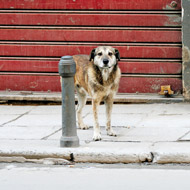Canine rabies kills 160 people a day

The poorest countries are at greatest risk of canine rabies.
160 people are dying every single day from canine rabies, according to a study published in PLOS Neglected Tropical Diseases.
The study is the first to consider the impact of rabies in terms of deaths and the economic costs of rabies across the world.
Even though the disease is preventable, the study reveals that around 59,000 people die every year of rabies transmitted by dogs.
Carried out by the Global Alliance for Rabies Control (GARC), the study shows that annual economic losses because of the disease stand at around 8.6 billion US dollars. This is largely due to premature deaths, but also because of spending on human vaccines and lost income for victims of animal bites.
GARC's executive director, professor Louis Nel, said that the work is an 'essential step' towards improved control and eventual elimination of rabies.
"An understanding of the actual burden helps us to determine and advocate for the resources needed to tackle this fatal disease," he added.
Led by Dr Katie Hampson of the University of Glasgow, the study is the first to estimate the impact of canine rabies and the extent of control effort in every country in the word.
Dr Hampson explains: "The breadth of data used in this study, from surveillance reports to epidemiological study data to global vaccine sales figures, is fare greater than ever analysed before, allowing this more detailed output."
The report shows that the poorest countries are at greatest risk of canine rabies; the death rate is highest in countries in sub-Saharan Africa, while India has the highest number of fatalities (over 20,000 human deaths annually). The proportion of dogs vaccinated is far below what is deemed necessary to control the disease across all countries of Africa and Asia.
Rabies is close to 100 per cent fatal, but it is almost 100 per cent preventable. GARC say that the best, most cost-effective way of preventing canine rabies is by vaccinating dogs. In fact, the countires that have invested most in dog vaccination are those where human deaths from the disease have almost beem wiped out.
The report also shows that reporting systems are key to eliminating rabies, to monitor and assess the success of prevention efforts.
"No one should die of rabies and GARC and its partners will continue to work together using a One Health approach towards global rabies elimination," says professor Nel.



 The RCVS has announced a new version of its 1CPD mobile app, with enhanced features for veterinary surgeons and veterinary nurses to record their continuing professional development.
The RCVS has announced a new version of its 1CPD mobile app, with enhanced features for veterinary surgeons and veterinary nurses to record their continuing professional development.